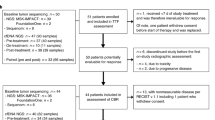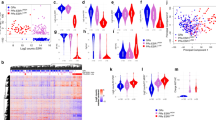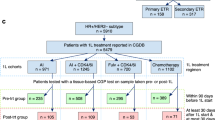Abstract
Tumor evolution is shaped by many variables, potentially involving external selective pressures induced by therapies1. After surgery, patients with estrogen receptor (ERα)-positive breast cancer are treated with adjuvant endocrine therapy2, including selective estrogen receptor modulators (SERMs) and/or aromatase inhibitors (AIs)3. However, more than 20% of patients relapse within 10 years and eventually progress to incurable metastatic disease4. Here we demonstrate that the choice of therapy has a fundamental influence on the genetic landscape of relapsed diseases. We found that 21.5% of AI-treated, relapsed patients had acquired CYP19A1 (encoding aromatase) amplification (CYP19A1amp). Relapsed patients also developed numerous mutations targeting key breast cancer–associated genes, including ESR1 and CYP19A1. Notably, CYP19A1amp cells also emerged in vitro, but only in AI-resistant models. CYP19A1 amplification caused increased aromatase activity and estrogen-independent ERα binding to target genes, resulting in CYP19A1amp cells showing decreased sensitivity to AI treatment. These data suggest that AI treatment itself selects for acquired CYP19A1amp and promotes local autocrine estrogen signaling in AI-resistant metastatic patients.
This is a preview of subscription content, access via your institution
Access options
Access Nature and 54 other Nature Portfolio journals
Get Nature+, our best-value online-access subscription
$29.99 / 30 days
cancel any time
Subscribe to this journal
Receive 12 print issues and online access
$209.00 per year
only $17.42 per issue
Buy this article
- Purchase on Springer Link
- Instant access to full article PDF
Prices may be subject to local taxes which are calculated during checkout




Similar content being viewed by others
Accession codes
Change history
31 January 2017
In the version of this article initially published online, the names of authors Hermannus Kempe and Pernette J. Verschure were spelled incorrectly. These errors have been corrected in the print, PDF and HTML versions of this article.
References
Nowell, P.C. The clonal evolution of tumor cell populations. Science 194, 23–28 (1976).
Early Breast Cancer Trialists' Collaborative Group (EBCTCG). Relevance of breast cancer hormone receptors and other factors to the efficacy of adjuvant tamoxifen: patient-level meta-analysis of randomised trials. Lancet 378, 771–784 (2011).
Pagani, O. et al. Adjuvant exemestane with ovarian suppression in premenopausal breast cancer. N. Engl. J. Med. 371, 107–118 (2014).
Early Breast Cancer Trialists' Collaborative Group (EBCTCG). Aromatase inhibitors versus tamoxifen in early breast cancer: patient-level meta-analysis of the randomised trials. Lancet 386, 1341–1352 (2015).
Musgrove, E.A. & Sutherland, R.L. Biological determinants of endocrine resistance in breast cancer. Nat. Rev. Cancer 9, 631–643 (2009).
Carroll, J.S. et al. Chromosome-wide mapping of estrogen receptor binding reveals long-range regulation requiring the forkhead protein FoxA1. Cell 122, 33–43 (2005).
Magnani, L. et al. Genome-wide reprogramming of the chromatin landscape underlies endocrine therapy resistance in breast cancer. Proc. Natl. Acad. Sci. USA 110, E1490–E1499 (2013).
Fuqua, S.A., Chamness, G.C. & McGuire, W.L. Estrogen receptor mutations in breast cancer. J. Cell. Biochem. 51, 135–139 (1993).
Fribbens, C. et al. Plasma ESR1 mutations and the treatment of estrogen receptor–positive advanced breast cancer. J. Clin. Oncol. 34, 2961–2968 (2016).
Robinson, D.R. et al. Activating ESR1 mutations in hormone-resistant metastatic breast cancer. Nat. Genet. 45, 1446–1451 (2013).
Toy, W. et al. ESR1 ligand-binding domain mutations in hormone-resistant breast cancer. Nat. Genet. 45, 1439–1445 (2013).
Nguyen, V.T.M. et al. Differential epigenetic reprogramming in response to specific endocrine therapies promotes cholesterol biosynthesis and cellular invasion. Nat. Commun. 6, 10044 (2015).
Curtis, C. et al. The genomic and transcriptomic architecture of 2,000 breast tumours reveals novel subgroups. Nature 486, 346–352 (2012).
Beroukhim, R. et al. Assessing the significance of chromosomal aberrations in cancer: methodology and application to glioma. Proc. Natl. Acad. Sci. USA 104, 20007–20012 (2007).
Gao, J. et al. Integrative analysis of complex cancer genomics and clinical profiles using the cBioPortal. Sci. Signal. 6, pl1 (2013).
Cancer Genome Atlas Network. Comprehensive molecular portraits of human breast tumours. Nature 490, 61–70 (2012).
Cao, Q. et al. CaSNP: a database for interrogating copy number alterations of cancer genome from SNP array data. Nucleic Acids Res. 39, D968–D974 (2011).
Koivisto, P. et al. Androgen receptor gene amplification: a possible molecular mechanism for androgen deprivation therapy failure in prostate cancer. Cancer Res. 57, 314–319 (1997).
Visakorpi, T. et al. In vivo amplification of the androgen receptor gene and progression of human prostate cancer. Nat. Genet. 9, 401–406 (1995).
Chen, Z., Katzenellenbogen, B.S., Katzenellenbogen, J.A. & Zhao, H. Directed evolution of human estrogen receptor variants with significantly enhanced androgen specificity and affinity. J. Biol. Chem. 279, 33855–33864 (2004).
Dunn, C.A., Clark, W., Black, E.J. & Gillespie, D.A.F. Estrogen receptor activation function 2 (AF-2) is essential for hormone-dependent transactivation and cell transformation induced by a v-Jun DNA binding domain–estrogen receptor chimera. Biochim. Biophys. Acta 1628, 147–155 (2003).
Park, J., Czapla, L. & Amaro, R.E. Molecular simulations of aromatase reveal new insights into the mechanism of ligand binding. J. Chem. Inf. Model. 53, 2047–2056 (2013).
Ali, S., Buluwela, L. & Coombes, R.C. Antiestrogens and their therapeutic applications in breast cancer and other diseases. Annu. Rev. Med. 62, 217–232 (2011).
Cao, Z. et al. Effects of resin or charcoal treatment on fetal bovine serum and bovine calf serum. Endocr. Res. 34, 101–108 (2009).
Li, Y., Sidore, C., Kang, H.M., Boehnke, M. & Abecasis, G.R. Low-coverage sequencing: implications for design of complex trait association studies. Genome Res. 21, 940–951 (2011).
Shaw, L.E., Sadler, A.J., Pugazhendhi, D. & Darbre, P.D. Changes in oestrogen receptor-α and -β during progression to acquired resistance to tamoxifen and fulvestrant (Faslodex, ICI 182,780) in MCF7 human breast cancer cells. J. Steroid Biochem. Mol. Biol. 99, 19–32 (2006).
Jeng, M.H. et al. Estrogen receptor expression and function in long-term estrogen-deprived human breast cancer cells. Endocrinology 139, 4164–4174 (1998).
Goldhirsch, A. et al. Personalizing the treatment of women with early breast cancer: highlights of the St Gallen International Expert Consensus on the Primary Therapy of Early Breast Cancer 2013. Ann. Oncol. 24, 2206–2223 (2013).
Cibulskis, K. et al. Sensitive detection of somatic point mutations in impure and heterogeneous cancer samples. Nat. Biotechnol. 31, 213–219 (2013).
Pruneri, G. et al. The transactivating isoforms of p63 are overexpressed in high-grade follicular lymphomas independent of the occurrence of p63 gene amplification. J. Pathol. 206, 337–345 (2005).
Kempe, H., Schwabe, A., Crémazy, F., Verschure, P.J. & Bruggeman, F.J. The volumes and transcript counts of single cells reveal concentration homeostasis and capture biological noise. Mol. Biol. Cell 26, 797–804 (2015).
Baccelli, I. et al. Identification of a population of blood circulating tumor cells from breast cancer patients that initiates metastasis in a xenograft assay. Nat. Biotechnol. 31, 539–544 (2013).
Al-Hajj, M., Wicha, M.S., Benito-Hernandez, A., Morrison, S.J. & Clarke, M.F. Prospective identification of tumorigenic breast cancer cells. Proc. Natl. Acad. Sci. USA 100, 3983–3988 (2003).
Lephart, E.D. & Simpson, E.R. Assay of aromatase activity. Methods Enzymol. 206, 477–483 (1991).
Zhang, Y. et al. Model-based analysis of ChIP-Seq (MACS). Genome Biol. 9, R137 (2008).
Younesy, H. et al. An interactive analysis and exploration tool for epigenomic data. Comput. Graph. Forum 32, 91–100 (2013).
Acknowledgements
We thank all participants and their families. We thank A. Bardelli for his comments. We thank D. Patten for help with the exemestane study. We thank L. Watson for her help with the manuscript. We thank J.Bean for support. For these studies, S.M. and G.P. were supported by Associazione Italiana Ricerca sul Cancro (AIRC) (5x1000 campaign). L.M. was supported by the Imperial College Junior Research Fellowship. S.-P.H. was supported by Cancer Research UK (CRUK) grant C37/A18784. Y.P. was supported by CRUK PhD studentship P55374. G.C. was supported by the EpiPredict project (European Union's Horizon 2020 research and innovation program under the Marie Skłodowska-Curie grant agreement 642691).
Author information
Authors and Affiliations
Contributions
L.M. conceived the study and wrote the manuscript. L.M., S.M. and G.P. planned and supervised all experiments. L.M., G.F., S.-P.H., Y.P., R.M.G., S.F., H.K., and V.V. performed experiments. G.C. and I.B. performed bioinformatics analyses. P.J.V., G.V., A.N., M.S., A.T., S.A. and M.A.C. provided reagents, samples and intellectual contribution. All authors discussed the results and commented on the manuscript.
Corresponding authors
Ethics declarations
Competing interests
The authors declare no competing financial interests.
Integrated supplementary information
Supplementary Figure 1 Treatment histories of patients with CYP19A1 amplification in the discovery cohort.
Treatment history for the six patients from the AI discovery cohort with acquired CYP19A1 amplification. PD, progressive disease; PR, partial response (according to Response Evaluation Criteria in Solid Tumors: RECIST standards).
Supplementary Figure 2 Treatment histories of patients with CYP19A1 amplification in the validation cohort.
Treatment history for the six patients from the AI validation cohort with acquired CYP19A1 amplification. PD, progressive disease; PR, partial response (according to Response Evaluation Criteria in Solid Tumors: RECIST standards).
Supplementary Figure 3 CYP19A1 locus CNAs in primary cancers.
CNA meta-analysis of primary breast cancers. (a) CYP19A1 locus. (b) ESR1 locus. Figures were generated using cBioPortal. Only datasets with potential CNA data are presented. Cancers are grouped and color-coded based on tissue of origin. CNA analysis was obtained using GISTIC.
Supplementary Figure 4 ESR1 locus CNAs in metastatic breast cancers and PDX models.
(a) CNA TaqMan analysis for potential ESR1 amplification in the validation cohort. Copy number values are normalized to the adjacent normal tissue and to an internal normalizer (either TERT or RNASEP). (b) CNA TaqMan analysis for potential ESR1 amplifications in the PDX cohort (obtained from patients treated with SERM/AI as indicated by the lower panel).
Supplementary Figure 5 CYP19A1 CNAs can be due to focal amplification as assayed by TaqMan.
(a) Graphical representation of GABRB3 locus, and its position with respect to the CYP19A1 locus. Normalization to the GABRB3 locus can help to identify focal (signal at the CYP19A1 locus > GABRB3) vs. whole chromosome amplification (signal at the CYP19A1 locus ≍ GABRB3). (b) Combined plot of all clinical datasets.
Supplementary Figure 6 CYP19A1 CNAs can be due to focal amplification as assayed by FISH.
Representative FISH images for the validation dataset. One case of CYP19A1 amplified and one case of CYP19A1 wild type are shown. The summary of TaqMan results and FISH ratio (CYP19A1/ 15 alpha satellite) is reported in the table.
Supplementary Figure 7 Mutational landscape of breast cancer drivers in patients with primary breast cancer.
SNV meta-analysis of primary breast cancers. (a) Cumulative frequency of CNA and SNV mapping at the PIK3CA, MAP3K1, GATA3, TP53, ESR1 and CYP19A1 loci in primary breast cancers. These genes were profiled in our targeted sequencing panel. (b) SNVs for the sequenced genes in a recent TCGA dataset including all breast cancer subtypes. (c) SNVs for the sequenced genes in the 2012 TCGA dataset restricted to luminal A/B (ERα-positive) patients. Mutational frequencies for the Luminal A and Luminal B subsets are included in the bottom panel (from two different TCGA datasets).
Supplementary Figure 8 Mutational landscape of breast cancer drivers in patients with metastatic breast cancer.
(a) Total depth of sequencing coverage and statistics for activating ESR1 mutations in Tamoxifen and AI patient samples. Allele frequencies (AF) are also reported as a fraction of the total number of sequenced and aligned reads. SNVs were called against adjacent matched normal tissue. (b) Boxplots for individual patient/mutations in the AI cohorts. DNA was re-extracted from patients included in Figure 2d and re-analyzed on a separate experiment using an Ampliseq custom panel. Patients’ identifiers from CYP19A1-amplified samples are highlighted in green boxes; ESR1-amplified patients are highlighted in bold. A summary of the mutation frequencies is shown in the table below.
Supplementary Figure 9 CYP19A1 CNAs in breast cancer cell lines.
(a) ERα breast cancer cell lines treatment history and derivation. (b) Potential CNV called by MACS within chromosome 15. CYP19A1 is located at the center of the dense cluster (black box). (c) Close up of the CYP19A1 amplicon in the six cell lines. The panels show raw reads (SAM file) at the boundaries of the amplicon
Supplementary Figure 10 CYP19A1 activity and manipulation in breast cancer cell lines.
(a) Aromatase activity assay. Various breast cancer cell lines were assayed for aromatase enzyme activity. Aromatase activity is higher in LTED cells than in MCF7 cells, and it is significantly impaired by letrozole treatment. Columns and bars represent mean and s.e.m. from three independent experiments. Asterisks represent significant difference after one-way ANOVA with Tukey’s post-test. (b) CYP19A1 mRNA was depleted using two independent siRNA. Bar represent fold change in mRNA levels measured with qRT-PCR and compared to a control siRNA using two alternative intron-spanning primers. Columns and bars represent mean and s.e.m. from three independent experiments. Asterisks represent significant difference after one-way ANOVA with Dunnet’s post-test. (c) CYP19A1 was overexpressed using a CYP19A1 ORF. Bar represent fold change in mRNA levels measured with qRT-PCR and compared to a control plasmid using two alternative intron-spanning primers. Columns and bars represent mean and s.e.m. from three independent experiments. Asterisks represent significant difference after Student’s t-test. (d) Growth of CYP19A1amp LTED cells was tested in response to the SERM Tamoxifen and the SERD Fulvestrant. Data are reported as the ratio of SRB units between day 6 and day 1. Columns and bars represent mean and s.e.m. from three independent experiments. Asterisks represent significant difference after a ANOVA test. Significance levels are as follows: *P < 0.05, **P < 0.01, ****P < 0.0001.
Supplementary Figure 11 Uncropped western blot for analysis of CYP19A1 in breast cancer cell lines.
Top. Lane 1: MW marker. Lanes 2-7: MCF7, MCF7T, MCF7F, LTED, LTEDT and LTEDF. Antibody: CYP19A1.
Bottom. Lane1: MW marker. Lanes 2-7: MCF7, MCF7T, MCF7F, LTED, LTEDT and LTEDF. Antibody: β-actin
Supplementary information
Supplementary Text and Figures
Supplementary Figures 1–11 and Supplementary Note (PDF 1369 kb)
Supplementary Table 1
Estimation of CYP19A1 amplification in primary cancers using SNP arrays SNP array-based CNV analysis of several cancer studies has been performed using http://cistrome.org/CaSNP/ (see Online Methods). A summary of the results is shown. (XLSX 38 kb)
Supplementary Table 2
Probe lists for mutational profiling using Ion Torrent technology BEDFILE containing the genomic coordinates of the probes used for the AmpliSeq custom panel. (XLSX 53 kb)
Supplementary Data 1
Ion Torrent called mutations in patients treated with tamoxifen Report summaries for each patient treated with single adjuvant tamoxifen were generated using Ion Reporter (https://ionreporter.thermofisher.com/ir/). Each tab contains the results from paired analyses (normal-metastasis). Labeling of each patient is concordant with the labeling from the main text. (XLSX 178 kb)
Supplementary Data 2
Ion Torrent called mutations in patients treated with aromatase inhibitors Report summaries for each patient treated with single adjuvant aromatase inhibitors were generated using Ion Reporter (https://ionreporter.thermofisher.com/ir/). Each tab contains the results from paired analyses (normal-metastasis). Labeling of each patient is concordant with the labeling in the main text. (XLSX 500 kb)
Rights and permissions
About this article
Cite this article
Magnani, L., Frigè, G., Gadaleta, R. et al. Acquired CYP19A1 amplification is an early specific mechanism of aromatase inhibitor resistance in ERα metastatic breast cancer. Nat Genet 49, 444–450 (2017). https://doi.org/10.1038/ng.3773
Received:
Accepted:
Published:
Issue Date:
DOI: https://doi.org/10.1038/ng.3773
This article is cited by
-
Nuclear lncRNA NORSF reduces E2 release in granulosa cells by sponging the endogenous small activating RNA miR-339
BMC Biology (2023)
-
A molecular toolbox to study progesterone receptor signaling
Journal of Mammary Gland Biology and Neoplasia (2023)
-
Relationship between serum lipid levels and the immune microenvironment in breast cancer patients: a retrospective study
BMC Cancer (2022)
-
Association of ST6GAL1 and CYP19A1 polymorphisms in the 3′-UTR with astrocytoma risk and prognosis in a Chinese Han population
BMC Cancer (2021)
-
The immunomodulatory effects of endocrine therapy in breast cancer
Journal of Experimental & Clinical Cancer Research (2021)



